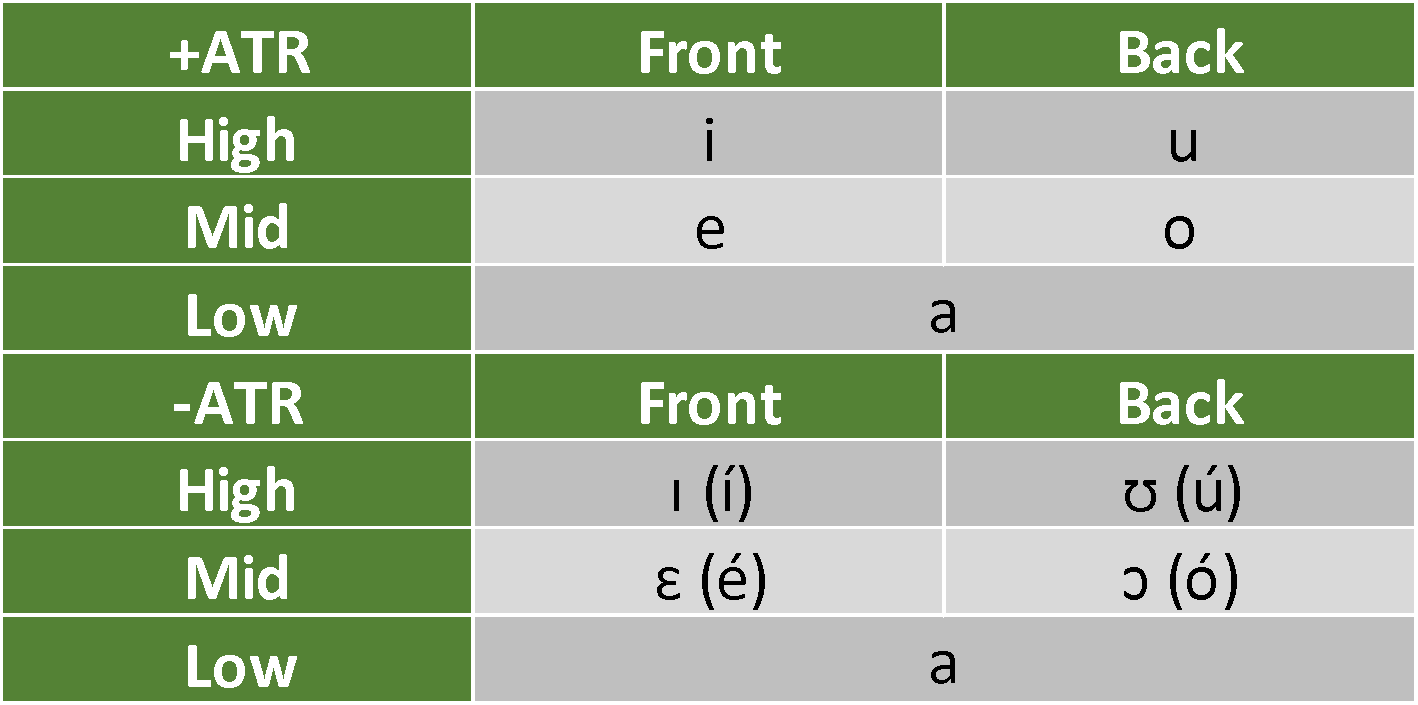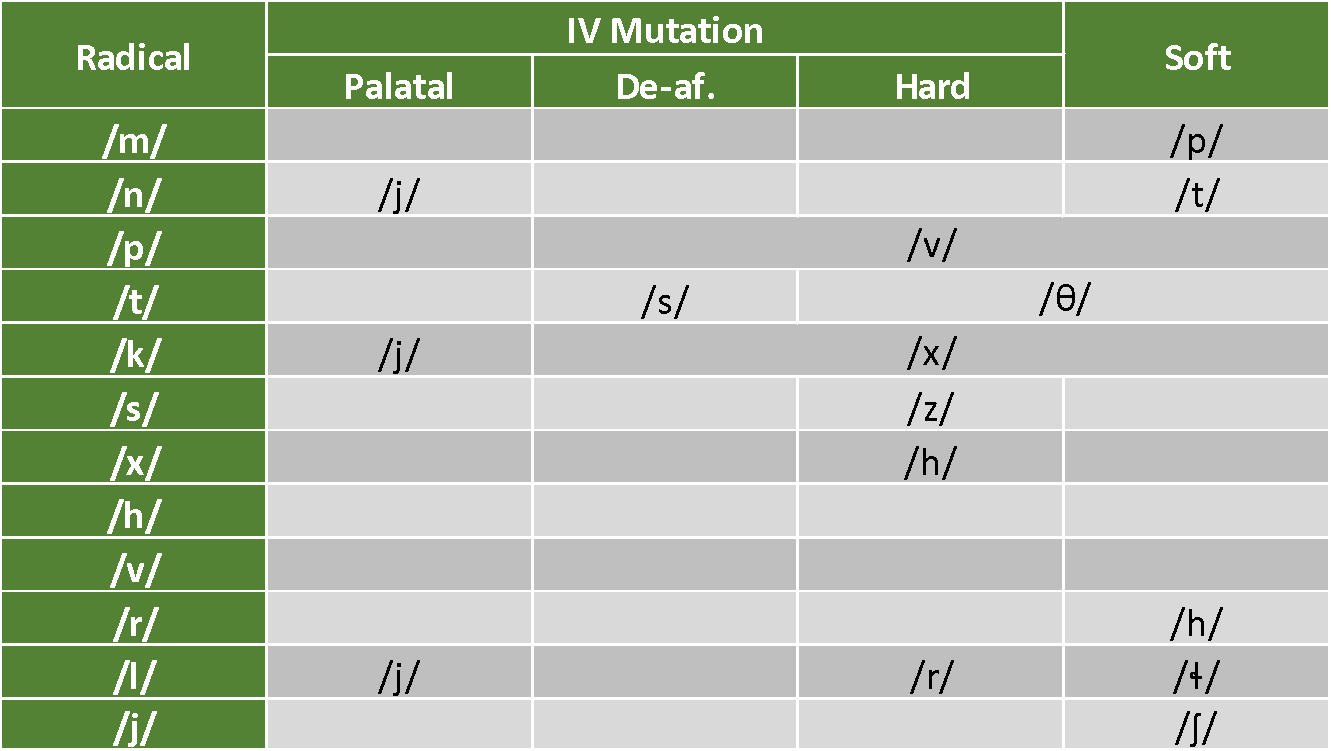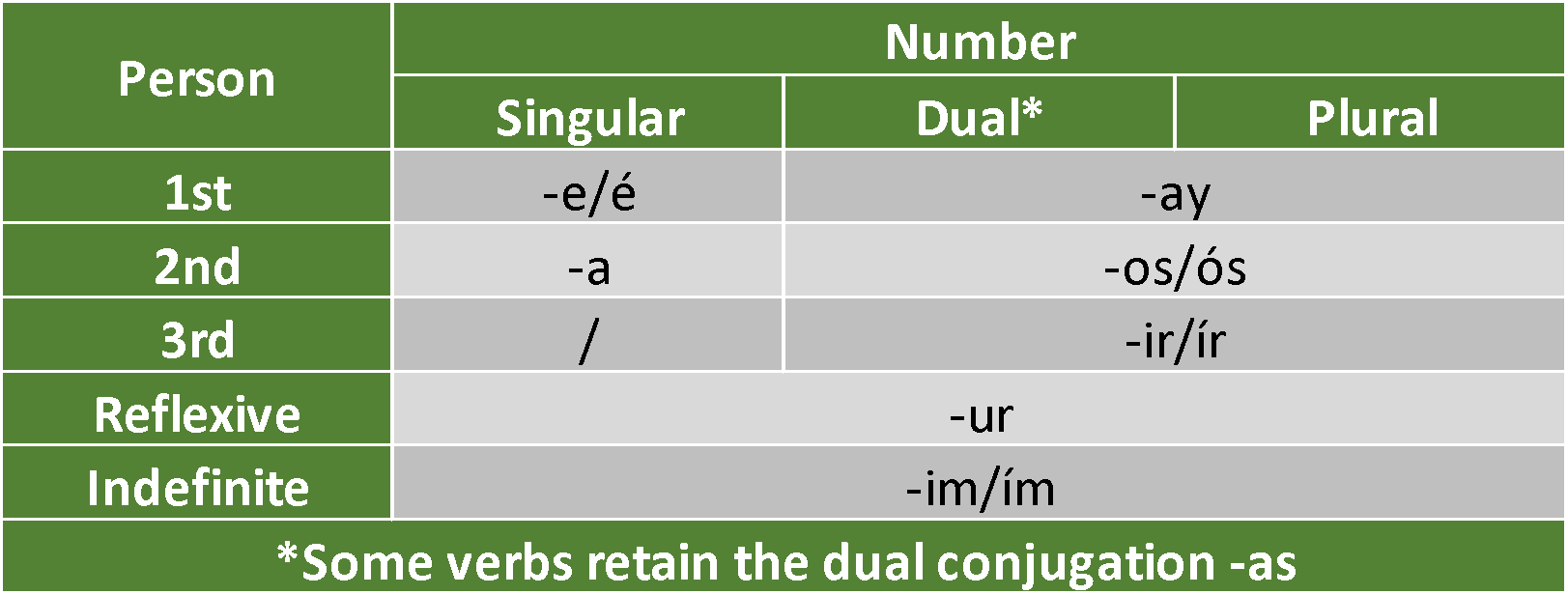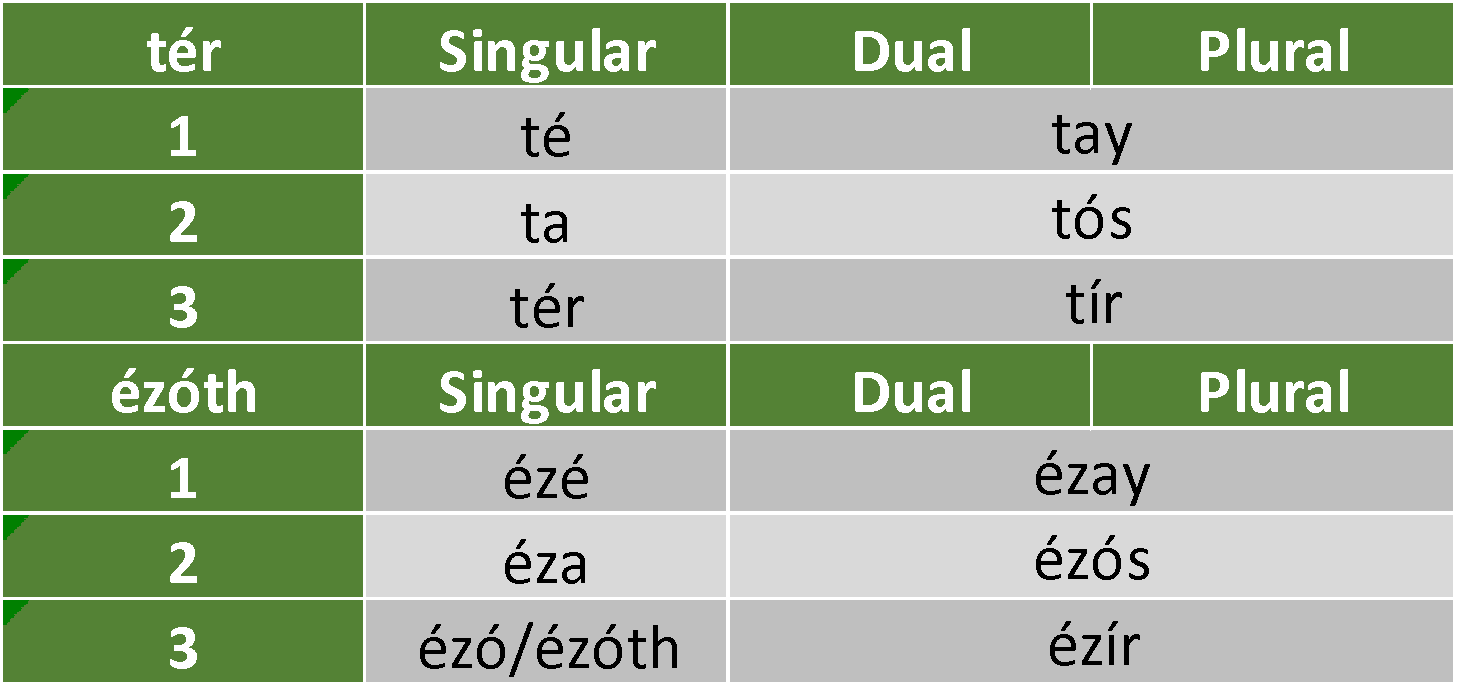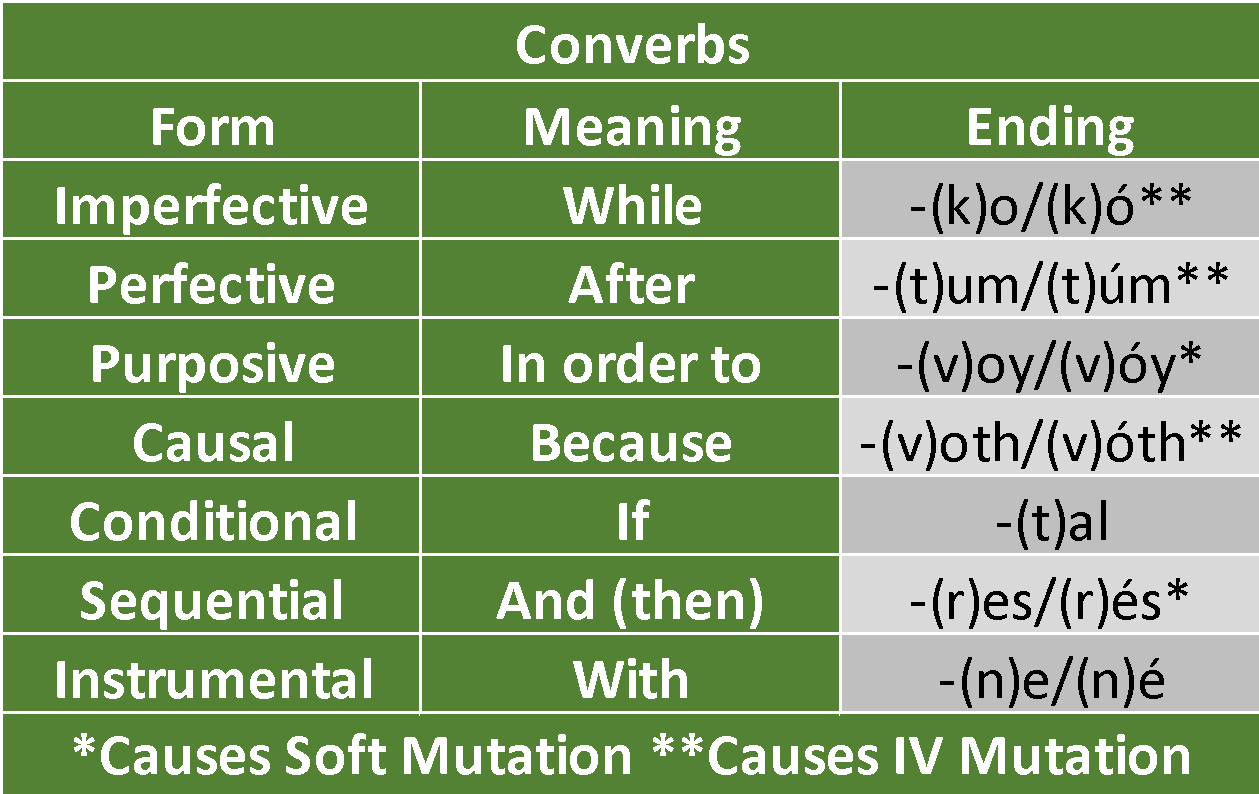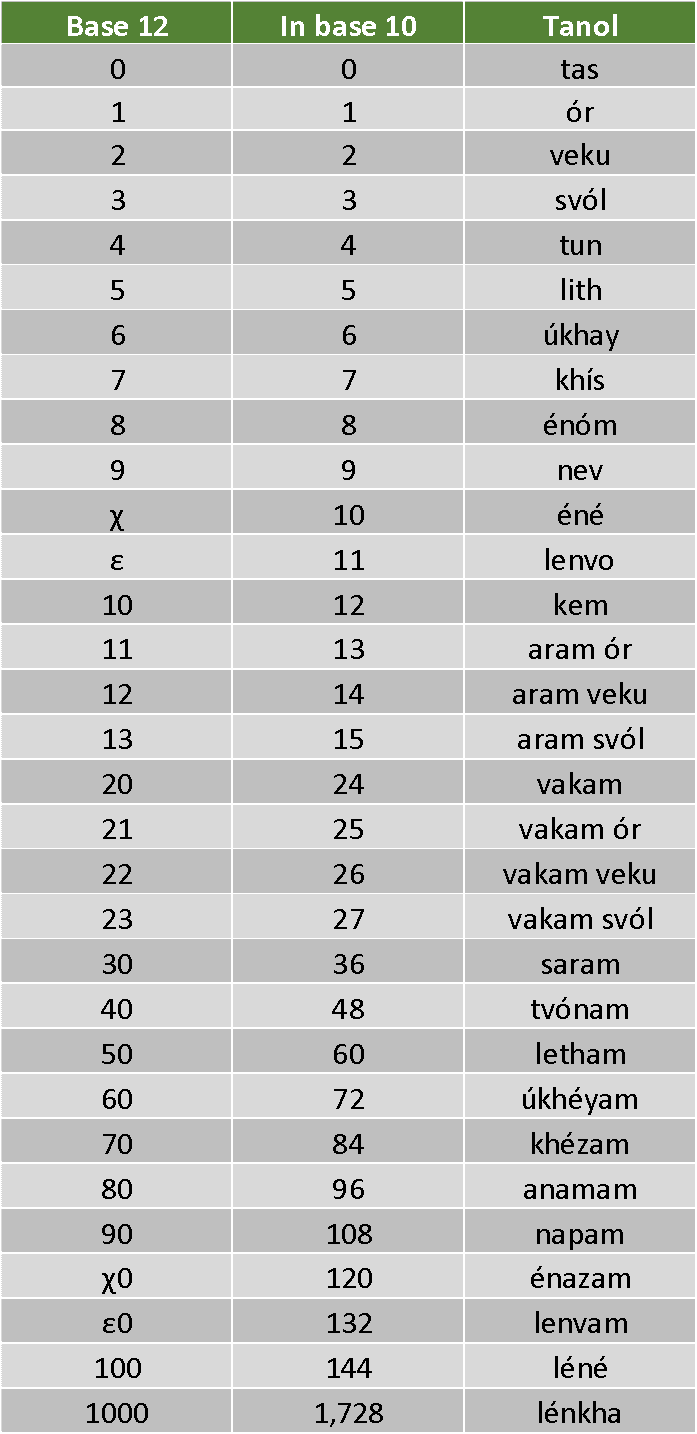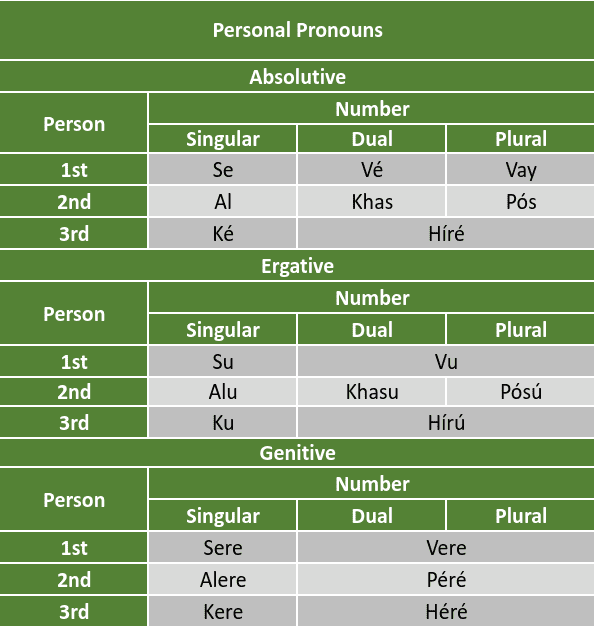Tanol: A Reference Grammar
Autor: Harry Cook
MS-Datum: 01-06-2022
FL-Datum: 08-01-2022
FL-Nummer: FL-000083-00
Zitat: Kochen, Harry. 2022. “Tanol: A Reference
Grammar.” FL-000083-00, Fiat Lingua,
Urheberrechte ©: © 2022 Harry Cook. Dieses Werk ist lizenziert
unter einer Creative Commons Namensnennung-
NonCommercial-NoDerivs 3.0 Unportierte Lizenz.
http://creativecommons.org/licenses/by-nc-nd/3.0/
Fiat Lingua wird von der Language Creation Society produziert und gepflegt (LCS). Für mehr Informationen
über die LCS, Besuchen Sie http://www.conlang.org/
0\
CONTENTS
1
Einführung
1.1
1.2
1.3
1.4
1.5
Entwicklung
Influences
Context
Acknowledgements
Final remarks
2
Phonologie
2.1
2.2
2.3
2.4
Konsonanten
Vokale
Prosody
Phonotactics
3 Morphophonology
3.1
3.2
3.3
3.4
Vowel harmony
Initial consonant mutation
A-mutation
Phonological irregularities in inflection
4 Morphology and Syntax
4.1
4.2
4.3
4.4
4.5
4.6
4.7
4.8
4.9
Verbs
Negation and Interrogation
Converbs
Fluid-S ergative split
Nouns
Modifiers
Numbers
Pronouns
Prepositions
4.10
Syntax
5
Derivation
5.1
5.2
5.3
Nominal derivation
Verbal derivation
Borrowings and loanwords
6
Dialects
1
1
2
3
3
4
5
5
5
6
6
7
7
7
8
8
9
9
13
14
17
18
19
21
22
22
23
25
25
26
26
28
6.1
Southern Tanol
6.2 Western Tanol
6.3
6.4
6.5
6.6
Central Tanol
Eastern Tanol
Northern Tanol
Comparison of the dialects
28
28
28
28
29
29
1 INTRODUCTION
Tanol is a naturalistic artlang I started working on at the end of 2020 and finished towards
the end of 2021, containing numerous linguistic features that I love such as ergativity,
converbs, consonant mutation, vowel harmony and rich dialectal variation.
1
1.1 DEVELOPMENT
The initial idea and name for Tanol are from as far back as mid-2018, stemming from the
world-building project the language is ultimately a part of. The original plans share some
features as the final version of the language, such as Celtic style initial consonant mutation
and a Bulgarian and/or pseudo-Basque style verb system with a Persian inspired dual verb
root system. Other ideas came to me later in the planning stage such as ATR vowel harmony2
and initially a lack of inflected verb agreement that was later changed.
Tanol was made, like all my conlangs, with the historical method. When I create any new
naturalistic conlang I start with a proto-language (in the case of Tanol, Proto-Tarikhic) und
evolve it forwards through time, applying sound and grammatical changes as I go. Das
means that what you see in this grammar is very much the tip of the iceberg of what went
into making Tanol, but as I tend to write my grammars as though my conlangs were real
world languages; therefore I cannot speak too much of its evolution from the point of view
of a conlanger, but as a linguist who has encountered this language for the first time.
Tanol as a language was fairly swift in its development. Though one could argue I spent the
better part of nearly two years roughly planning the language in my head, the planning
period took place over September and October of 2020 and the bulk of the main
development was only around five months, spanning the end of 2020 to the beginning of
2021, with some revisions made over the summer 2021 and this grammar was written over
September-November. Tanol is probably one of my most well-planned conlangs, welche
contributed to its quick development, but I was also just very excited to make the language.
The biggest changes to the language throughout development happened to the
phonological inventory. While I had a fairly good idea of how I wanted to the language to
work grammatically, I did not have a particular phonaesthetic in mind while planning the
language. I wanted a vaguely Celtic feel, but I was scared about being too derivative when I
was already taking great influence from Celtic morphophonology. I settled on a rough middle
ground between Russian, Welsh and Persian, though other influences eventually came about
as I was enacting sound changes.
There were several sounds I was thinking about including but eventually decided against
such as /q/, /ħ/, /ʒ/ and /ɮ/. Aber, I wanted to keep to a smaller consonant inventory as
1 Artlangs are a subset of conlangs specifically developed for artistic purposes, as opposed to international
communication like auxlangs/IALs (Esperanto, usw) or to test linguistic concepts and/or hypotheses like
engelangs (I’d place Toki Pona and Ithkuil in this category but their creators might disagree).
2 The ATR vowel harmony I developed was originally going to be part of another language I was planning at the
time but I changed my mind and used it in Tanol instead.
1
I was going to have at least two major morphophonological processes in the language and
some of these sounds were already in Paghade, another conlang of mine. Tanol and Paghade
are already related and I wanted to keep them as distinct as possible.
3
There were already some relatively rare sounds in Tanol and adding even rarer ones did not
sit well with me. Zum Beispiel, /ħ/ is not only cross-linguistically very rare, but adding it
would have created a three way distinction between /x/, /ħ/ and /h/; this distinction can
and does exist in Arabic but including it felt not only derivative of Arabic but just wrong for
what Tanol was becoming.
The development of the grammar was very smooth, the basic idea for the verb system had
been forming in my head for years and the rest of the language came from that. The fluid-s
ergative system came from some reading I was doing about Guaraní at the time, und das
idea of converbs came later in development but seemed to fit the grammatical systems I had
already created by that point.
Other elements came to me as I was doing the regular preparatory pre-conlanging reading
of books such as The Art of Language Invention by David J. Peterson and Advanced Language
Construction by Mark Rosenfelder. Another book I read before I started making the language
was African Languages An Introduction edited by Bernd Heine and Derek Nurse. Das ist
where the entire idea of ATR vowel harmony came to me, and for a while I was considering a
tone system reminiscent of West African languages, though I shelved this idea and plan to
use it in a future conlang instead.
Tanol turned out nearly exactly how I wanted it to, which as a conlanger who is very
self-critical really excited me. Other conlangs I had developed, while I was happy with some
parts of them, always felt amateurish . Tanol was a huge step towards developing what I
consider top tier naturalistic artlangs such as David J. Peterson’s Dothraki, Biblaridion’s
Nekāchti and Mark Rosenfelder’s Kebreni.
4
1.2 INFLUENCES
I drew influence from a large variety of languages for Tanol, which are listed below:
Akan | Ákán (Tano, Niger-Congo)
Ancient Greek | Ἑλληνική Hellēnikḗ (Hellenic, Indo-European)
Basque | Euskara (Isolate)
Bulgarian | български Bǎlgarski (South Slavic, Indo-European)
–
–
–
–
– Guaraní | Avañeʼẽ (Tupi-Guarani, Tupian)
–
–
–
–
Khalkha Mongolian | Халх аялгуу Khalkh ayalguu (Central Mongolian, Mongolic)
Koreanisch | 한국어 Hangugeo (Koreanic, Isolate)
Latin | Lingua Latīna (Italic, Indo-European)
Persian | ﯽﺳرﺎﻓ Fārsi (Iranian, Indo-European)
5
3 Both are Tarikhic languages.
4 Especially the names, as I still stuck to -ese, -ian, -ic and -ish based names, Paghade was originally called
“Pagadian” and when I first came up with the name, Tanol was “Tanolic”.
5 Word does not support the traditional Mongolian script.
2
Russian | Pусский язык Russkiy yazyk (East Slavic, Indo-European)
Spanish | Español/Castellano (Ibero-Romance, Indo-European)
–
–
– Welsh | Cymraeg (Celtic, Indo-European)
When choosing influences for Tanol I wanted to go more Indo-European than I normally
would when making a conlang. Aber, I dislike any conlang of mine to look or sound like
any real-world language or language family, so at the same time I wanted to make sure that
the language would not look too “European” or even “Indo-European”. This is where the
grammatical influence of Guaraní, Korean and Basque entered the picture, Korean actually
being a later influence but I think it really helped to make Tanol seem distinctive and not be
too “European”.
Welsh and Akan had the greatest influence on phonology and morphophonology, und dann
for flair I looked into Khalkha Mongolian, Spanish (specifically Andalusian Spanish) und
Russian which helped to create the (Meiner Meinung nach) distinctive phonaesthetic of the
language. I have heard Tanol descried phonologically as similar to Polish, Armenian, Welsh,
Hebrew and Arabic; one person described it as “West African with a bit of Latin and Russian
in it”.
1.3 CONTEXT
Within the context of its fictional world, Tanol is a member of the Tarikhic language family, An
language family that covers much of the Doromeran continent. The speakers of Tanol are the
Ruhem, who live in a large area of Doromeran they simply call Anthes, which contains many
independent city states (the largest being Tamaris) each with their own distinct dialect of
Tanol. There exists also the svókazavéra tiveme (merchants’ dialect) which is based on the
dialect of Tamiris and is often used as a kind of lingua franca between the different dialects
and as the standard language of trade around the Doromeran .6
In terms of its lexicon, Tanol was influenced by the Classical Hazari’i language, des!Laqone
Empire, especially when Proto-Tanolic was spoken (when the !Laqone Empire was at its
peak). Select Tanol words relating to government, warfare, the arts and science were
borrowed from or influenced by Classical Hazari’i.
While there are modern descendants of Classical Hazari’i spoken in the region south of
Anthes, these languages have not had such an influence on Tanol as the other way around,
as Tanol is now the prestige language of the area. Classical Hazari’i has had an impact on
certain dialects of Tanol as I will explore in the dialects section of this grammar.
1.4 ACKNOWLEDGEMENTS
I would like to give a massive thanks to all those who listened to me prattle on in the last
year about the process of making Tanol while I was actually making it, especially fellow
conlanger Jonah Behring (AKA Käntwo) whose constant enthusiasm and feedback helped
shape Tanol into the language it became. A big thanks to all my other friends who have put
6 This grammar focuses primarily on svókasavéra tiveme and all tables, words and example sentences are in
svókasavéra tiveme unless otherwise stated.
3
up with me and this very niche hobby of mine, both those in linguistics (especially Evelyn
Parsons and Anneke Visser) and those who know nothing about it. I also owe thanks to my
some of tutors, Heather Turner and Elliot Holmes, at the University of York whose guidance
and feedback also informed many decisions made while making the language.
1.5 FINAL REMARKS
Tanol is not a finished conlang by any means and this grammar will be updated as certain
aspects of the language are updated. There are large elements which have not yet been
completed such as pragmatics and a writing system. Darüber hinaus, the lexicon is currently, während
not insignificant, still rather small (several hundred words). Right now, this grammar serves
as a current look at the main aspects of this conlang.
If you have read this grammar and want to know more about the language, want to ask me
questions about it or simply want to get in touch, my email is [email protected].
Depending on how busy I am I will try to get back to you as quickly as possible to respond to
your question. If you are a conlanger who wants advice or to chat about this conlang or my
other conlangs please feel free to contact me.
If you are a writer or worldbuilder in need of a conlang or conlangs, I am available for hire as
language creator. Auf diese Weise, please feel free to view Tanol as a kind of portfolio. Tell me
what kind of language you want and how thorough you want it to be and I can give you a
price as well as a rough deadline for completion.
Conlanging is a very niche and complex hobby which takes a lot of time, üben, creativity
and talent. I am always so flattered when non-conlangers and even non-linguists show
interest in my conlangs because it is such a strange hobby to have. Whenever people say
that my languages “seem real” or they show interest in actually learning them I get a huge
sense of validation.
Tanol feels like my best conlang so far, while I still have many more years of conlanging
ahead of me, Tanol is a huge milestone in my conlangs and I look forward to seeing how I
can develop further from this point because I think my next few projects will yield equally
fascinating and well developed results as Tanol. I hope you enjoy reading about this conlang.
Harry Cook – 2021
4
2 PHONOLOGY
Tanol has quite an interesting phonology, with an average sized consonant inventory, An
relatively large vowel inventory and some strict phonotactic rules.
2.1 CONSONANTS
The consonants of Tanol are as follows:
When the romanisation differs from the IPA, the romanisation is written in brackets.
Voiceless stops are always pronounced without aspiration, as in spot, stot and scot in
Englisch. /n/ and /t/ are pronounced as laminal denti-alveolar [n̪] und [t̪], with the blade of
the tongue on the alveolar ridge and teeth like in Italian, Spanish or Russian. /r/ is
pronounced as a full trill at the beginning of an utterance or at the beginning of a word if the
previous word ends in a consonant. It is more like a a tap or short trill intervocalically and is
usually devoiced to [r̥] word finally. /l/ is retracted to be post-alveolar [l̠] in coda position. /ʃ/
becomes [ɕ] before high vowels. /k/ is fronted and slightly fricated before high vowels and
/x/ is more palatal [ç] before high front high vowels.
2.2 VOWELS
As Tanol features ATR vowel harmony, the language has essentially two vowel inventories:
In vowel hiatus, between each vowel a glide is pronounced and there are no full diphthongs.
Vowels in hiatus tend to move closer to each other in articulation. The exact pronunciations
of vowels are shown on the chart on the next page.
Exact pronunciation of vowels is incredibly important not just because of the harmony
system but also because there are grammatically distinct words which are distinguished only
5
by their ATR vowel quality. This is especially
common for -ATR vowel-initial short form verbs,
where the long form is made by making the
vowels +ATR. Zum Beispiel:
Su rakh ézéún – I will sing
Su rakh ezeun – I have sung
2.3 PROSODY
Stress in Tanol categorically falls on the first
syllable of a word:
Yazan (sun) – /ˈja.zan/
Leyokun (wine) – /ˈle.jo.kun/
Púnvóray (chair) – /ˈpʊ.nvɔ.ɾaj/
The only exception to this rule is some loan words, especially those coming from Classical
Hazari’i. Aber, in words that are particularly common, the stress is moved to the first
Silbe.
Tanol is syllable timed isochronically, so every syllable takes up roughly the same amount of
time and unstressed vowels maintain their quality. The lack of long vowels and geminates
paired with syllable timing gives the language a very quick, “rapid fire” sound, especially in
normal speech.
2.4 PHONOTACTICS
Tanol disallows geminates and word final clusters. Any sound may begin a word, but words
can only end with:
– Nasals
–
–
/v/, /θ/, /s/ and /x/
Approximants
/i/ and /ɪ/ are also not permitted to end a word in most dialects.
A /v/ is permitted to follow any initial consonant in a word except /h/, in cases where there
would be a /hv/ cluster, /h/ becomes /x/. Tanol is quite strict in how word internal
consonant clusters may be formed. Here are the rules for clustering and hiatus:
–
–
–
Any nasal followed by an obstruent (except /h/) – kínsél (to write)
Any nasal followed by an obstruent (except /h/) followed by /v/ – antvo (capital city)
Any two vowels of the same vowel harmony may be in hiatus – véízé (to be strong)
6
3 MORPHOPHONOLOGY
Tanol features three different morphophonological systems and some phonological
irregularity in inflection and derivation.
3.1 VOWEL HARMONY
As previously mentioned Tanol features an ATR (advanced tongue root) vowel harmony
System, in which +ATR vowels (or tense vowels) may not occur in the same word as -ATR
vowels (or lax vowels). /a/ is transparent to harmony and may occur with either set of
vowels. This system means that any affix containing a vowel other than /a/ has two forms,
one with a +ATR vowel and one with a -ATR vowel.
There are no major exceptions to vowel harmony, the only notable ones being some loan
words, although many speakers will force these words to adhere to vowel harmony, usually
decided upon by the quality of the vowel in the stressed syllable.
3.2 INITIAL CONSONANT MUTATION
Tanol features initial consonant mutation, where the first consonant of a root in an open
word class will change depending on the word that comes before it. Tanol features four
types of consonant mutation: palatal mutation, de-affricating (or de-af.) mutation, hard
mutation and soft mutation. These mutations are as follows:
Mutations do not always affect every word beginning with a certain radical, and the same
word can cause different mutations on the following word. Zum Beispiel, eyo causes IV
mutation, this means that a word beginning with /t/ could become /s/ or /θ/ or just not
change at all:
–
–
–
Tórím – to run (away) (cid:0) Eyo sórímé – I ran away
Tíyúné – to draw (cid:0) Su menva eyo thíyúné – I drew a woman
Tus – to hit (cid:0) Su eyo tus – I hit him/her
7
While there are some rules that are universal across the mutations like all non-loan words
beginning with /s/ and /x/ undergoing hard mutation and all words beginning with a
sonorant undergoing soft mutation. Other than that, the exact mutation class must be
memorised (especially words beginning with voiceless stops which are quite unpredictable).
The words that trigger mutation are mostly function words like copulae, demonstratives,
prepositions and some high frequency adjectives and adverbs.
Mutations are not always treated the same way across different dialects, for example some
dialects ignore de-af. and/or palatal mutation. This is discussed further in the dialects
Kapitel.
There is also an irregular paradigm, whereby random words beginning with /v/ with gain /x/
word initially in hard mutation, and other words beginning with a vowel will gain an initial
/h/:
–
–
Vón – night (cid:0) Ésé khvón – tonight
Eme – to breath in (cid:0) Eyo heme – S/he breathed in
3.3 A-MUTATION
A-mutation is the next of the major morphosyntactic processes in Tanol. A small, Aber
relatively prominent, set of suffixes in the language cause the final vowel of the stem to
lower. These include the plural suffix for C-class nouns as well as some derivational affixes.
–
–
–
Írvór – Pale ale (cid:0) Írvórú ékhóth – The pale ale is tasty
Írvarav – Pale ales (cid:0) Írvaravú ékhóth – The pale ales are tasty
Kvózín – To forge (cid:0) Kvózéya – Blacksmith
3.4 PHONOLOGICAL IRREGULARITIES IN INFLECTION
There is also a large number of words which undergo consonant mutation when inflected, oder
sometimes sounds just appear, seemingly at random. These irregularities are a result of
sound changes dating back to the proto-language and must be memorised.
–
Svóka – Merchant (cid:0) Kó khemer svóka tér – The merchant is in the room
(cid:0) Kó khemer svókazav tír – The merchants are in the room
(cid:0) Svókasú rveke mere – The merchant loves money
– Mere – To love (cid:0) Svókasú mere – The merchant loves him/her
(cid:0) Svókasú meria – The merchant loves you
–
Kvózín – To forge (cid:0) Su yóvósé eyo khvózín – I will forge a sword
(cid:0) Su yóvósav eyo khvózíyír – I will forge some swords
8
4 MORPHOLOGY AND SYNTAX
Tanol morphology is unusual to say the least, typologically it shows elements of synthesis
and also arguably analysis. There are several parts of Tanol morphology which really make
the language quite awkward to learn and on top of this the language is far from regular.
4.1 VERBS
On the face of things, verbs in Tanol might appear very simple:
–
–
–
–
Verbs only have two forms: a short form and a long form which are often
etymologically related to each other.
Verbs are only marked for one argument.
Lexical verbs are not marked for tense, aspect, or mood.
There are only four auxiliary verbs which are used to create different
tense-aspect-mood meanings.
Aber, each of these facts have several caveats attached to them; in fact verbs in Tanol
are quite complicated.
Verbs are marked for only one argument, but this argument is neither exactly for the subject
or the object, it is either for one of them or neither depending on the case marking and
transitivity in the sentence. There is set of suffixes which mark the absolutive argument in a
sentence, rather than the solely the subject or the object. This suffix always goes on the
lexical verb, not the auxiliary.
These endings are suffixed directly onto the stem, regardless of whether it ends in a vowel
or consonant. Aber, if the final vowel of the stem is the same as the first and second
person singular markers when conjugating for those persons or if the stem ends with two
vowels, then an epenthetic -s- is infixed:
Rakh pémpasa – You have gone
AUXI.IMP go.PERF-2.SG
Rakh pémpay – We have gone
AUXI.IMP go.PERF-1.PL
Rakh téósa – You will go
AUXI.IMP go.IMP-2.SG
9
Rakh téósay – We will go
AUXI.IMP go.IMP-1.PL
In an intransitive sentence with a volitional verb, the suffix marks the subject:
Tórímé – I am running
run.IMP-1.SG
In an intransitive sentence with a non-volitional verb, the suffix is omitted as there is no
absolutive argument:
Su lémís(-Ø) – I am sleeping
1.SG.ERG sleep.IMP
In a transitive sentence, the suffix marks the object:
Su meria – I love you
1.SG.ERG love.IMP-2.SG
This point of grammar is particularly alien for speakers of many other languages and is a
constant thorn in the side of learners of the language. This is also the beginning of the many
awkward elements of Tanol verbal morphology.
The reflexive can be added to any transitive verb to create a reflexive meaning, like the -self
suffix after a pronoun in English:
Vu véólúr – We see ourselves
1.PL.ERG see.IMP-REFL
It can be reduplicated to create a reciprocal meaning:
Vu véólúzúr – We see each other
1.PL.ERG see.IMP-REFL.REFL
7
The indefinite suffix can be used when the object of a sentence is unknown:
Kharathu véólím – The man sees someone/thing
man-ERG see.IMP-INDEF
This can be used to create a passive meaning by promoting the subject to the absolutive:
Kharath véólím – The man is seen
man.ABS see.IMP-INDEF
Literally: Someone/thing sees the man
The agent may not be restated in a passive construction in Tanol.
The indefinite can also be used to create the anti-passive by promoting the original ergative
argument to an absolutive one and what would have been the absolutive argument (Die
Objekt) to a prepositional phrase with vúyé:
Kharath vúyé lhúthéú véólím – The man sees the dog
man.ABS for dog-ERG see.IMP-INDEF
7 The /r/ of the original suffix becomes /z/ due to the dissimilative rule whereby an intervocalic /r/ becomes /z/
when bordering another syllable containing /r/.
10
The anti-passive is most often utilised when the speaker wishes to use an S/P pivot and
delete the subject of the second clause:
Kharath eyo mizu kharathu lúthé vévéólés – The man arrived and then the man saw the dog
man.ABS AUXII.PERF arrive.IMP man-ERG dog.ABS see.PERF-SEQU.CONV
Lúthé eyo mizu kharathu vévéólés – The dog arrived and then the man saw the dog
dog.ABS AUXII.PERF arrive.IMP man-ERG see.PERF-SEQU.CONV
Kharath eyo mizu vúyé lhúthéú vévéólímés – The man arrived and then saw the dog
man.ABS AUXII.PERF arrive.IMP for dog-ERG see.PERF-INDEF-SEQU.CONV
In a non-third person anti-passive construction, the speaker could leave in the person suffix
after the indefinite marker if they wish, but it may be (and often is) deleted as the person is
more often than not clear from context:
Eyo mizue vúyé lhúthéú vévéólímérés – I arrived and then saw the dog
AUXII.PERF arrive.IMP-1.SG for dog-ERG see.PERF-INDEF-1.SG-SEQU.CONV
Eyo mizue vúyé lhúthéú vévéólímés – I arrived and then saw the dog
AUXII.PERF arrive.IMP-1.SG for dog-ERG see.PERF-INDEF-SEQU.CONV
Verbs in Tanol have two forms, a short form and a long form which are used to create a wide
array of tense, aspect and modal meanings when combined with the four auxiliary verbs in
the language. These short and long forms come from an old reduplication paradigm in the
proto-language. In the gloss, the short form is shown as .IMP and the long as .PERF; this is to
do with etymology as the verbal meanings have drifted beyond the old
imperfective-perfective distinction of Proto-Tarikhic.
Verbs are always cited in their both their short and long forms as while very often these
forms are etymologically related, there are often seemingly unpredictable changes that
happen to the short form to create the long form. This usually involves infixing, vowel
mutation or, more rarely, suppletion. Without knowing a verb’s exact etymology and the
sound changes that it has undergone, there is no way to know for sure how the long form
will appear.
Tas (cid:0) Tathas – to say
Lémís (cid:0) Léyamís – to sleep
Éyén (cid:0) Ayen – to say
Amer (cid:0) Athamer – to fight
Téó (cid:0) Némpa – to go
The bare short form is used for the present tense and the bare long form is the nominalised
form of the verb (which is frequently used to form nouns from verbs, especially those with a
more abstract meaning).
The four auxiliary verbs derive from copulae in the Proto-Tarikhic. The verbs are now called
auxiliary I and auxiliary II (AUXI and AUXII in the gloss).
11
These each have their own short and long forms and create the following verbal meanings
when combined with a lexical verb.
Tanol makes a distinction between three aorist evidential aspects:
The simple aorist:
Eyo ekav – S/He spoke
AUXII.PERF speak.IMP-3.SG
The inferential:
Te ekav – It is evident that s/he spoke
AUXI.IMP speak.PERF-3.SG
The renarrative:
Vóm ekav – It is said/I have been told that s/he spoke
AUXI.PERF speak.PERF-3.SG
The subjunctive is used to describe any hypothetical situation:
Véy ranim te pizuay véy kókóyétal – If we leave now we can arrive sooner
now leave.PERF-COND.CONV more quickly AUX.IMP arrive.IMP-1.PL
The imperative is used for orders:
Vóm amera! – Fight!
AUXI.PERF fight.IMP-2.SG
Some verbs, like amer, retain the old second person dual conjugation (especially iin the
imperative):
Vóm ameras! – (You two) fight!
AUXI.PERF fight.IMP-2.DL
Tanol distinguishes between three base past tenses in a similar way that English does:
Aorist (equivalent to the English simple past):
Vu eyo ameros – We fought you
1.PL.ERG AUXII.PERF fight.IMP-2.PL
Perfect:
Vu rakh athameros – We have fought you
1.PL.ERG AUXII.IMP fight.PERF-2.PL
Pluperfect:
Vu eyo athameros – We had fought you
1.PL.ERG AUXII.PERF fight.PERF-2.PL
12
And finally, Tanol has a distinct future tense:
Su rakh lémís – I will sleep
1.SG.ERG AUXII.IMP sleep.IMP
Tanol has a copula tér, ézóth “to be” which is used roughly how English speakers would
expect it to be used. The subject of the copula never takes the ergative case and because of
this person marking on the copula always refers to the subject.
Due to its frequent use, the copula has special forms for the different conjugations:
The copula may also be dropped in the present tense in situations where it is clear from
context, although this is generally associated with very colloquial speech:
Sere héyó Inarin tér (cid:0) Sere héyó Inarin – My name is Inarin
1.SG.GEN name.ABS Inarin.ABS be.IMP (cid:0) 1.SG.GEN name.ABS Inarin.ABS
4.2 NEGATION AND INTERROGATION
Verbs in Tanol may take with negative and interrogative prefixes. They can also be stacked, in
which case either prefix may come first depending on the meaning the speaker wishes to
imply.
The prefixes are:
Some example sentences:
Alu kévéólay – You do not see us
2.SG.ERG NEG-see.IMP-1.PL
Alu athívéólay – Do you see us?
2.SG.ERG INTER-see.IMP-1.PL
Alu athíkévéólay – Do you not see us?
2.SG.ERG INTER-NEG-see.IMP-1.PL
Alu kathívéólay – Do you not see us?
2.SG.ERG NEG-INTER-see.IMP-1.PL
The prefixes also block the stem being mutated. The negative k(é)- prefix takes palatal and
soft mutation, the interrogative doesn’t take any mutation.
13
Zum Beispiel:
Alu te yévévéólay – It is evident you did not see us
2.SG.ERG AUXI.IMP NEG-see.PERF-1.PL
Alu eyo khévévéólay – You had not seen us
2.SG.ERG AUXII.PERF NEG-see.PERF-1.PL
Alu te athívévéólay – Is it the case that it is evident that you saw us?
2.SG.ERG AUXI.IMP INTER-see.PERF-1.PL
Alu eyo athívévéólay – Had you seen us?
2.SG.ERG AUXII.PERF INTER-see.PERF-1.PL
4.3 CONVERBS
The only other major morphological marking that verbs take is a suffix rendering them as a
converb. These converbs are recent innovations in Tanol grammar, evolving in Proto-Tanolic
from suffixing prepositions onto nominalised verb forms. These converbs are used in clause
chaining, derivation and for creating periphrastic verbal constructions.
Clauses containing a converb tend to come before the main clause but can come after if the
speaker wants to front the main clause. They are assumed to have the same verb agreement
as the lexical verb unless otherwise specified. This means that if the lexical verb is transitive
with a third person object, the converb, regardless of transitivity is assumed to have this as
its absolutive argument. This seems confusing but can be understood through some
Beispiele.
If we take a transitive verb like natev (to stab):
Su eyo natev – I stabbed him/her
1.SG.ERG AUXII.PERF stab.IMP-3.SG
In this sentence, the verb is unmarked because it is transitive and has a third person singular
absolutive argument. If we add a converb to this sentence, it is assumed to take the same
absolutive argument as the lexical verb, which in this case is a third person one:
Ethakavum su eyo natev – After s/he spoke I stabbed him/her
speak.PERF-PERF.CONV 1.SG.ERG AUX.II.PERF stab.IMP
Ethakavetum su eyo natev – After I spoke I stabbed him/her
speak.PERF-1.SG-PERF.CONV 1.SG.ERG AUX.II.PERF stab.IMP
Despite each main clause having the same subject, only the first converb remains unmarked,
because it has the same absolutive argument as the lexical verb. If we were to use create a
similar construction but with a typically non-volitional intransitive verb:
Ku léyamísúm su eyo natev – After s/he slept I stabbed him/her
3.SG.ERG sleep.PERF-PERF.CONV 1.SG.ERG AUX.II.PERF stab.IMP
Léyamísúm su eyo natev – After s/he slept (by choice) I stabbed him/her
sleep.PERF-PERF.CONV 1.SG.ERG AUX.II.PERF stab.IMP
Su léyamísúm su eyo natev – After I slept I stabbed him/her
1.SG.ERG sleep.PERF-PERF.CONV 1.SG.ERG AUX.II.PERF stab.IMP
14
Léyamízétúm su eyo natev – After I slept (by choice) I stabbed him/her
speak.PERF-1.SG-PERF.CONV 1.SG.ERG AUX.II.PERF stab.IMP
Alternativ, an anti-passive construction could be used:
Su léyamísúm vúyé ku eyo natevime – After I slept I stabbed him/her
1.SG.ERG sleep.PERF-PERF.CONV for 3.SG.ERG AUXII.PERF stab.IMP-INDEF-1.SG
Léyamísúm vúyé ku eyo natevime – After I slept (by choice) I stabbed him/her
sleep.PERF-PERF.CONV for 3.SG.ERG AUXII.PERF stab.IMP-INDEF-1.SG
8
9
Any one of these constructions may be used by the speaker depending on the exact
meaning the speaker wishes to imply, or what information they wish to front.
The converb suffix is added after any verb morphology if present. The converb is always
assumed to have the same tense-aspect-mood as the lexical verb, if this is not the case, An
converb cannot be used.
There are seven converb suffixes in Tanol which are shown on the next page:
The meaning of these converbs is shown in the middle column but these meanings can be
context dependent.
The imperfective converb when used in clause chaining creates the meaning of “while” or
“in the process of”:
Athamero kharath eyo yíral – The man stood while fighting/and fought
fight.PERF-IMP.CONV man-SG.ABS AUXII.PERF stand.IMP
The perfective converb when used in clause chaining creates the meaning of “after” or
“having completed/finished”:
Khvóhamóv vévéólúm eyo sórímé – After I saw the snakes I ran away
snake-PL.ABS see.PERF-PERF.CONV AUXII.perf run.IMP-1.SG
8 Here the first person singular verb ending must be used because the verb arguments in the two clauses do
not match; first person ergative vs first person singular
9 Here, the person would not be clear from context if the ending were omitted; the sentence would be
assumed to have a third person subject – After s/he slept (by choice) s/he stabbed him/her
15
É khomonokh sózóyúrúm rakh lémízé – After I have read this book, I will sleep
this book-SG.ABS read.PERF-3.PL-PERF.CONV AUXII.IMP sleep.IMP-1.SG10
The purposive converb has the meaning of “in order to” or often more simply just “to”.
While it is used in clause chaining it is most often used to write phrases with an infinitive
verb in English or modal constructions:
Léyamízévóy su khomonokh eyo sóyúr – In order to sleep I read a book
read.PERF-1.SG-PURP.CONV book-SG.ABS AUXII.PERF read.IMP-3.SG
Tanolim ethakavoy éhanúé – I can speak Tanol/I know how to speak Tanol
Tanol-ADV speak.PERF-PURP.CONV know.IMP-1.SG
More literally: I know in order to speak in a Tanol way
Ku léyamísóy kínthé – S/He begins to sleep
3.SG.ERG sleep.PERF-PURP.CONV begin.IMP
The causal converb has the meaning of “because”, “as”, “due to the fact (Das)” or any similar
connective in English:
Léyamísóth khomonokh ethakavoy eyo yimay – He stopped reading the book because he fell
asleep
sleep.PERF-CAUS.CONV the book.ABS read.PERF-PURP.CONV AUXII.PERF stop.IMP-3.SG
The conditional creates a condition which the main clause fulfils. The verb in the main clause
will be marked with the subjunctive:
Nénthatal su Tanol te senku – If I wanted (An) I would learn Tanol
want.PERF-CONV.COND 1.SG.ERG the Tanol.ABS AUXI.IMP learn.IMP
The sequential converb lists events as taking place after each other, unlike other converbs,
the sequential converb tends to come after the lexical verb:
Alu eyo amere tórím – You fought me (und) then ran away
2.SG.ERG 1.SG.ABS AUXII.PERF fight.IMP run.PERF-SEQU.CONV
The instrumental converb creates the meaning of “by means of” or more simply “by” when
used in clause chaining:
Athamere eyo líríhóné – I had won by fighting
fight.PERF-INST.CONV 3.SG.ABS AUXII.PERF win.PERF
A recent development in many southern dialects is the use of the instrumental in deriving
new verbs, in which case it comes before the main verb phrase.
Ethakave amer – To argue (literally “to fight by means of speaking”)
Ethakave líhón – To achieve victory peacefully, to settle a discussion (literally “to win by
means of speaking”)
10 The reason why this seemingly non-volitional verb is marked with the absolutive is discussed in the next
Abschnitt.
16
4.4 FLUID-S ERGATIVE SPLIT
Tanol is an ergative-absolutive language which features a fluid-s split. This means that the
marking on the subject of an intransitive verb will change between the ergative and
absolutive cases depending on whether the verb implies volition or not.
Zum Beispiel, speaking is a volitional act and so in Tanol, so the subject of the verb ekav (An
speak) is marked in the absolutive:
Ekave – I am speaking
speak-1.SG
Andererseits, sleeping is a non-volitional act, generally one doesn’t choose to fall
asleep, so in Tanol the subject of lémís (to sleep) is marked in the ergative:
Su lémís – S/He is sleeping
1.SG.ERG sleep
Please note that unlike active-s alignment, this system is purely semantic, and so the same
verb can trigger either alignment depending on context.
The verb néúkh can mean either to slip or to slide depending on the marking on the subject,
as to slip has essentially the same meaning as to slide just without volition:
Eyo yéúkh – S/He slid
AUXII.PERF slide.IMP-3.SG
Ku eyo yéúkh – S/He slipped
3.SG.ERG AUXII.PERD slide.IMP-3.SG
When extra marking or context is added to an intransitive verb this can also change the
marking on the subject. So lémís is ordinarily a non-volitional verb but if one adds the adds
the verb néth (to want) to the sentence:
Léyamísóy vóm nénthaír – Apparently they wanted to sleep
sleep.PERF-PURP.CONV AUXI.PERF want.PERF-3.PL
Ähnlich, the future tense generally causes non-volitional verbs to become volitional but this
is highly dependent on the semantic environment:
Su ésé khvónú rakh lémís – I will sleep tonight
1.SG.ERG by night-ERG AUXII.IMP sleep.IMP
Here sleeping is interpreted as being non-volitional as it is like a habitual action that the
speaker does not choose to do. It can be read as “tonight I will fall asleep like I normally do”:
Su khomonokh sózóyúrúm, rakh lémízé – Having read the book, I will sleep
1.SG.ERG book read.PERF-PERF.CONV AUXII.IMP sleep.IMP
Here sleeping is interpreted as being volitional as it is implied to be a planned action by the
speaker, that is the speaker wants or plans to carry out the action, thus implying volition. It
can be read as “after I have finished reading the book I plan to read, I will carry out the
sleeping I have also planned”.
17
The difference in meaning to an English speaker may seem inconsequential or even
non-existent but to Tanol speakers it is an intuitive part of the language, though equally an
infuriating part for learners.
Mastering this very fine point of Tanol grammar is one of the hardest aspects of the
language for learners. In der Tat, different dialects disagree in what context typically volitional
or non-volitional intransitive verbs change.
4.5 NOUNS
Nouns in Tanol take marking for case and number. Nouns fall into two declensions; V
declension, where a the nominal suffix is added directly to the root or a vowel based on the
phonologically history of the word is added before the nominal suffix and C declension
where a different vowel is added.
There are three grammatical numbers:
1. Singular – Exactly one of something
Kharath – The man
2. Dual – Exactly two of something
Kharatheno – The two men
3. Plural – Three or more
Kharathev – The men
There are three cases:
1. Absolutive
An. The subject of intransitive verbs of volition
Kharath ekav – The man is speaking
b. The direct object of transitive verbs
Menvau kharath mere – The woman loves the man
2. Ergative
An. The subject of intransitive verbs of non-volition
Kharathu lémís – The man is sleeping
b. The subject of transitive verbs
Kharathu menva tíyúné – The woman is drawing the woman
3. Genitive
The possessor of a noun phrase
11
Kharathere lhúthé – The man’s dog
11 Note that a noun in the genitive precedes the noun it describes and causes the following word to undergo
soft mutation
18
The declension for nouns is:
(V) stands for the vowel that is inserted.
Nouns are written in dictionaries in their citation form, the bare stem of the noun without
any marking and in the case of V declension words ending with a consonant, the theme
vowel will be given in brackets.
Zum Beispiel:
Ayeth(Ich) – Face (cid:0) Ayethino – Two faces (cid:0) Ayethinu – Two faces (erg)
Kharath(e) – Man (cid:0) Kharathev – Men (cid:0) Kharathevere – Men’s
Kékan(ú) – Morning (cid:0) Kékanúv – Mornings (cid:0) Kékanúvú – Mornings (erg)
Yúrév(ó) – Fruit (cid:0) Yúrévónó – Two pieces of fruit (cid:0) Yúrévónéré – Two pieces of fruits’
Téy(An) – Leaf (cid:0) Téyav – Leaves (cid:0) Téyavú – Leaves (erg)
V declension nouns which end with a vowel are given in their normal form.
Zum Beispiel:
Tirose – Ear (cid:0) Tiroseno – Two ears (cid:0) Tirosenu – Two ears (erg)
Yóvósé – Fang/sword (cid:0) Yóvósév – Fangs/swords (cid:0) Yóvósévéré – Fangs’/Swords’
Kónsé – Horse (cid:0) Kónsénó – Two horses (cid:0) Kónsénú
C declension nouns can either end with a consonant or a hidden consonant that only
appears when the word is declined. If the noun ends with a hidden consonant, it will be
given in brackets after the word. The hidden consonants can change depending on if the
suffix is a number or a case suffix, as was discussed in section 3.4. Another note is that the
plural suffix for C declension nouns causes the final vowel of the root to lower, except for
/a/.
Zum Beispiel:
Tivem – Tongue (cid:0) Tivamav – Tongues (cid:0) Tivamavere – Tongues’
Svóka(z/s) – Merchant (cid:0) Svókazénó – Two merchants (cid:0) Svókasú – Merchant (erg)
Emvokh(/v) – Foot (cid:0) Emvoveno – Two feet (cid:0) Emvovere – Foot’s
Beyond this single ending for case and gender, nouns take no other morphological marking,
though as I discuss in the derivation section, there are several derivational affixes present in
Tanol.
4.6 MODIFIERS
Adjectives in Tanol do not exist as such, instead there is a group of stative verbs that serve
the role of adjectives.
19
When used predicatively they function in exactly the same way as verbs:
Kharathu péyín – The man is tall
man-ERG be.tall.IMP
When used attributively, the verb is placed before the noun:
Péyín kharath – The tall man
be.tall.IMP man.ABS
A non-stative verb like sóyúr “to read” can be made into an adjective by turning it into an
imperfective converb then placing it before the noun:
Sózóyúró menva – The reading woman
the read.PERF-CONV.IMP woman.ABS
Adjectives have no inflected superlative, comparative or any other form, these meanings are
created with the word lekh “more” (which also triggers IV mutation). When used with a
stative verb it creates a comparative meaning, when used in conjunction with é it creates a
superlative meaning. The compared element in a comparative construction precedes the
noun and adjective and is used with the preposition tal “on, pertaining to”.
Ku lekh zayev – It is further away
3.SG.ERG more be.far.away.IMP
Lekh véyín kharath – The taller man
more be.tall.IMP man.ABS
É khu lekh zayev – It is furthest away
DET 3.SG.ERG more be.tall.IMP
É lhekh véyín kharath – The tallest man
DET more be.tall.IMP man.ABS
Tal menvau kharath lekh véyín – The man is taller than the woman
on woman.ERG man.ABS more be.tall.IMP
To create an equative meaning a sentence something like “the X is at/by the Y’s Zness” is
gebraucht, where the long form of the adjective is used:
12
Kharath ésé menvaere vévayín (tér) – The man is as tall as the woman
man.ABS by woman-GEN be.tall.PERF (be.IMP)
In Tanol there is only one determiner, é (which becomes ét when the following word begins
with a vowel). This particle serves as both a proximate and distal determiner (meaning Tanol
does not distinguish between “this” and “that”). It takes no case nor number marking and
causes the following word to under soft mutation. When a noun is preceded by a
preposition é is never used.
Adverbs of time or place tend to come at the beginning of a sentence, whereas those of
manner come immediately before the verb phrase. Non-lexical adverbs are created from the
short form of the stative verb or the absolutive form a noun with the suffix -im/ím:
12 To be may be omitted in this context.
20
Véy naye ranim Tanolim ekav – Right now the child is speaking Tanol quickly
now child.ABS be.fast.IMP-ADV Tanol.ABS-ADV speak.IMP
4.7 NUMBERS
Tanol features a base-12 number system, meaning in terms of base-10, Tanol speakers count
up to 12 before starting the next set of numbers. Numbers, like all modifiers, precede the
noun they modify, and nouns modified by numbers do not take number marking:
Tun menva – Four women
four woman.ABS
Here is the Tanol number system up to base-12 1000 (1728 in base-10):
21
4.8 PRONOUNS
Personal pronouns in Tanol decline for case and number in a similar way to nouns and other
pronouns don’t behave in a particularly outlandish way.
Personal pronouns are as follows:
Genitive pronouns precede the noun they describe and cause the following word to undergo
soft mutation.
The relative pronoun as such does not really exist in Tanol. To create a relative clause, An
converb of some description is typically used (see section 4.2). If the two clauses are
different in tense and aspect, then sentences are just placed adjacent to each other. Dabei
case, the relative clause tends to be placed before the main clause, but it can be placed
afterwards.
Sózóyúrúm su menva eyo véól – I saw the woman who was reading
read.PERF-PERF.CONV 1.SG.ERG woman.ABS AUXII.PERF see.IMP
Kéhanúé khasu tivamav ekavir – You two are speaking languages that I don’t know
NEG-know.IMP-1.SG 2.DL.ERG dialect.ABS speak.IMP 1.SG.ABS not know.IMP
Literally: You two are speaking languages (Das) I don’t know
22
4.9 PREPOSITIONS
As Tanol lacks local case marking, prepositions are the primary way to mark location and
locational adjuncts, unter anderem. Most prepositions also trigger some kind of
consonant mutation. Nouns in prepositional phrases always take the ergative case.
Tanol does not have a huge amount of core prepositions, most of them having multiple
meanings depending on context:
Many of these prepositions are used roughly how an English speaker might expect.
Zum Beispiel:
Ekh khvóhamónú eyo rúmaé – Because of the two snakes I ran (away)
because.of snake-DL.ERG AUX.II.PERF walk.IMP-1.SG
Kó urulu eyo rúmaé – I walked on the mountain(s)
in mountain-ERG AUXII.PERF walk.IMP-1.SG
Résé lhéthvónú eyo rúmaé – I walked (away) from the house
from house-ERG AUXII.PERF walk.IMP-1.SG
In the second sentence, where an English speaker might want to use a word like tal when
talking about walking on a mountain, Tanol speakers simply use kó to describe any kind of
spatial relation.
If one wanted to say “I walked inside the mountain” (maybe some kind of subterranean
cavern):
Kó urulere lhvasvau eyo rúmaé – I walked inside the mountain
in mountain-GEN inside-ERG AUXII.PERF walk.IMP-1.SG
Literally: I walked in the inside of the mountain
Ähnlich, “I sat on a chair” one would use kó instead of tal:
Kó vúnvórayú eyo púnvóé – I sat on the chair
in throne-DIM-ERG AUXII.PERF sit.IMP-1.SG
Tal púnvórayú eyo púnvóé – I sat on top of chair
on throne-DIM-ERG AUXII.PERF sit.IMP-1.SG
The second sentence implies the speaker is sitting on the top of the chair, maybe implying
they are sitting on the top of the back of the chair rather than the seat itself.
23
4.10 SYNTAX
As previously mentioned, Tanol is predominantly head-final, SOV language. For the most
part, modifiers precede their heads.
Nouns are always the last element in a noun phrase:
Ésé zere lékhím khúyél menvau insie – I am standing next to my beautiful wife
near 1.SG.GEN very be.beautiful.IMP woman-ERG stand.IMP-1.SG
In this sentence, the noun menva is preceded by the adposition, genitive pronoun, adverb,
and adjective.
Verbs are similarly the last element in a verb phrase:
Yvóth léthvóyú lékhím ranim eyo théósay – We very quickly went home
to house-ERG very fast.IMP-ADV AUXII.PERF
Here we see the verb follow an two adverbs and auxiliary verb.
In both of these examples we see an adverb (lékhím “very”) precede both an adjective and
another adverb.
Tanol word order is essentially restricted to SOV order. Prepositional phrases tend to come
first in a sentence and adverbs of manner tend to come before the verb or auxiliary verb.
The auxiliary verb and lexical verb may not be separated by other words.
Su kónsé véól – I see the horse
1.SG.ERG horse.ABS see.IMP
Subject-object-verb
Yvóth menvau su yóvósé rakh kél – I will give the woman a sword
to woman.ERG 1.SG.ERG sword.ABS AUXI.IMP give.IMP
Indirect object-subject-object-verb
Wh-questions are formed using the standard SOV structure:
Alu athe eyo véól? – Who/what did you see?
2.SG.ERG what AUXII.PERF see.PERF
24
5 DERIVATION
Tanol mostly prefers to derive new words from native sources rather than borrowing from
other languages, although this happens occasionally. It features some productive suffixes as
well as some less productive ones, the latter mostly originating from Proto-Tarikhic, in dem
case there has been significant semantic shifts in many cases from the original meanings.
5.1 NOMINAL DERIVATION
Many nouns are derived from verbs, and most derivational affixes attach to verbs. Some of
these affixes are much more productive and others are fossils left over from Proto-Tarikhic
or late Proto-Tarikhic derivational morphology.
Older suffixes tend to lead to some phonological changes to the root whereas newer suffixes
tend to attach to the root with no changes. Ähnlich, there is sometimes some semantic
extension from the meaning of the root in older suffixes whereas newer suffixes tend to stay
close to the original root.
Zum Beispiel, the old diminutive in Tanol is -e/é, coming from Proto-Tarikhic *-es. The new,
productive diminutive is -ay:
Insvor – Stone + -e (cid:0) Insvore – Bone
Insvor – Stone + -ay (cid:0) Insvoray – Pebble
Kemer – Room + -ay (cid:0) Kemeray – Small room, closet, cupboard
The old and new human agentive suffixes, -a and -is respectively, are similar in this regard:
Ruzu – To farm + -a (cid:0) Rvóza – Person
Ruzu – To farm + -is (cid:0) Ruzuis – Farmer
In many cases, such as rusu to rvóza speakers no longer see the old derivational suffix as
such. This does not mean there are no examples of more transparent relationships in old
derivational suffixes:
Nie – Branch + -e (cid:0) Nieze – Stick
There are a couple of older suffixes which are still productive, but they often trigger some
phonological mutation similar to nominal inflectional morphology. Such a suffix would be
the locative suffix -ar which causes A-mutation like the C declension plural:
Lémís – To sleep + -ar (cid:0) Lémísar – Bedroom
Ruzu – To farm + -ar (cid:0) Rvózar – Habituated area, population centre
As you may be able to guess from the example of ruzu, sometimes the semantic shift has
affected the root as well as the derived form. Ruzu comes from the Proto-Tarikhic word
*rūsū (to settle, begin to dwell, cultivate), which then drifted to the modern Tanol word ruzu
(to farm). Also, the original meaning of rvóza (or *rūsas as the Proto-Tarikhic form was) was
something like “one who settles” or “one who dwells”, and rvózar (*rūsare in Proto-Tarikhic)
was “a place that is settled”, which then shifted to mean a place that is populated. Ruzuis
25
first saw usage in Proto-Tanolic, where ruzu had started to mean to farm. So, with two
different agentive suffixes, the verb yields two nouns with different meanings.
There are other examples of semantic shifts causing interesting derivational histories. Für
Beispiel, the word for wolf in Tanol is lúthésír. This word is made of lúthé (dog) + ír
(augmentative), so literally a “big dog”. The word lúthé comes from Proto-Tarikhic *lyut
(wolf) and *-es (diminutive), so a “small wolf”. So, etymologically lúthésír literally means
something like a “a small big wolf”. Proto-Tarikhic *lyut was lost in the Tanolic subbranch but
was retained in other Tarikhic languages.
5.2 VERBAL DERIVATION
Verbal derivation is quite similar to nominal derivation, although there are fewer verbal
derivational suffixes. Some inflectional suffixes can be used derivationally, for example the
reflexive suffix:
Séríkh – To empty + ur (cid:0) Séríkúr – To vomit (literally to empty oneself)
The reflexive can also be used to create intransitive verbs from intransitive ones, in the case
of verbs which imply that the subject is both an agent and patient (almost as a kind of
mediopassive):
Alu léthvón eyo khúzókha – You burnt the house (runter)
2.SG.ERG house.ABS AUXII.PERF burn.IMP
Léthvónú kúzókhaúr – The house is burning (runter)
house-ERG burn.IMP-REFL (wörtlich: the house is burning itself)
Some nominal derivational suffixes, the augmentative and diminutive, can be used on verbal
roots:
Mékún – To cut, pierce + -ir (cid:0) Mékúnír – To dig
Túmvó – To tie + -e (cid:0) Túmé – To sew
Túmvó – To tie + -ir (cid:0) Túmvóír – To moor
A very productive suffix left over from Proto-Tarikhic is the causative -akh:
Nél – To die + -akh (cid:0) Nayakh – To kill
Kérú – To be empty + -akh (cid:0) Karakh – To wipe
The original meaning of kérú was “to be dry”, so karakh originally meant “to make dry”.
Overtime, both words shifted in meaning away from each other and the original meaning.
5.3 BORROWINGS AND LOANWORDS
Tanol tends not to take on many loan words, preferring to derive words from native sources,
but there are couple of loawords, especially in more specialist fields. Tanol has taken on
words from the languages around itn, especially Sān-pȳmo and Hazari’i.
The speakers of Sān-pȳmo, the Mỳnó, trade a lot with the city states of Anthes, besonders
those in the east, which border the territory of the Mỳnó. This trade is mostly made up of
spices, herbs, and other foods which grow in the island archipelagos stretching south-east of
26
the Doromeran continent. Hence the borrowings from Sān-pȳmo tend to be words related to
these things.
Some examples of words taken from Sān-pȳmo:
Sēn-her /s̠e˦n ħe˧r/ – Tea (cid:0) Senir13
Sēn-šòse – /s̠e˦n ɕose˧/ – Coriander (cid:0) Sensose
Ósá /osa/ – Cumin (cid:0) Osa
Qýs /qɨs/ – Cloves (cid:0) Kís
There are many of these examples, but these are some of the most common ones.
Borrowings from Hazari’i, specifically Classical Hazari’i tend to be related to things like
Wissenschaft, art, music, Literatur, and other elements of high society.14
13 Many sounds foreign to the Proto-Tanolic speakers who borrowed these words were either changed to more
familiar sounds or in the case of “weak” sounds like /h/ (which was present in Sān-pȳmo at this time but not
Proto-Tanolic; when /h/ shifted to /ħ/, the /i/ also lowered to /e/) were ignored.
14 Work on Classical Hazari’i and its daughter languages is very much in its infancy, so the grammar for Tanol
will be updated when the vocabulary for Tanol to borrow exists in Hazari’i.
27
6 DIALECTS
Tanol has many millions of speakers spread across a very large geographical area, this means
the language is rich in dialectal variation. These dialects are grouped into five large dialect
groups based on common linguistic, especially phonetic, features. These groups are
northern, westlich, central, eastern and southern; standard Tanol belonging to the latter
group. The dialects of Tanol start with Proto-Tanolic, when the Ruhem people started to
spread out more across Anthes new sound changes happened in some areas that didn’t in
Andere.
6.1 SOUTHERN TANOL
The southern dialect of Tanol is the one which has been discussed in this grammar so far, als
the svókazavéra tiveme is based on the southern dialect of the language. Like all dialect
groups there are specific dialects within this group such as the Tamiris dialect, but a
discussion of every major dialect could constitute its own book, probably one spanning
multiple volumes. Many younger speakers of the southern dialect are adopting a feature
very common to many western and northern dialects, where /ɛ/ is pronounced as /ɪ/.
6.2 WESTERN TANOL
Western Tanol features the aforementioned shift of /ɛ/ to /ɪ/. It also features a shift
whereby back vowels raise before nasals. Like a lot of western and northern dialects, Die
rhotic is always pronounced as a trill, and normally a retracted trill /r̠/. /ʃ/ is normally
pronounced as /ɕ/ too.
6.3 CENTRAL TANOL
In central Tanol, if in vowel hiatus the second vowel is higher than the first, the first vowel
will become long and the second vowel will be deleted, /ɔ/ is also frequently pronounced as
/ɑ/. /h/ is pronounced as pharyngeal /ħ/ due to the influence of nearby Sān-pȳmo, und
whereas in many other dialects, /h/ became /x/ at the end of a word, it was lost in central
Tanol. This means the word foot in central Tanol is pronounced as /emvo/ instead of
/emvox/. /r/ is retracted in central Tanol too and the Proto-Tanolic voiceless trill /r̥/ did not
become /h/ and stayed as a voiceless trill and it is normally retracted like its voiced
counterpart. /l/ is realised as /w/ at the end of a word, and unlike in other Tanol dialects
Proto-Tanolic /l̥/ did not become /ɬ/ but instead /t͡ɬ/. /ʃ/ is also usually pronounced as /ɕ/
and something unique to central Tanol is that Proto-Tanolic /w̥/ became /xʷ/.
6.4 EASTERN TANOL
Eastern Tanol was phonologically influenced a lot by Classical Hazari’i and still is by its
daughter languages and sounds very different to the other dialects a lot because of this. /R/
is usually a uvular trill /ʀ/ and the voiceless trill of Proto-Tanolic became /ʀ̥ / in this dialect
and then later /χ/. The lamino-dental consonants are pronounced as alveolar consonants,
and /θ/ is realised as /t̪/. Proto-Tanolic /ɣ/ became /x/ rather than /h/ like in many other
28
dialects. But like in central Tanol /l̥/ became /t͡ɬ/. /ɛ/ is normally realised as /a/ and back
vowels centralise to the schwa in hiatus with front vowels. Some words ending with mid
front vowels in other dialects end with high front vowels in eastern Tanol.
6.5 NORTHERN TANOL
The northern dialect has a lot in common with the central and western dialects. /ɬ/is realised
as /t͡ɬ/, /ɛ/ is realised as /ɪ/, /a/ is pronounced as /ɛ/ and /ɔ/ and /ʊ/ are both pronounced
as /ɔ/. Like in eastern Tanol, there are some words that end in /i/ that end with /e/ in the
north, and on top of this /s/ was not lost word finally in northern Tanol. The voiceless trill
didn’t become /h/ either and mid and low vowels are pronounced as a schwa in vowel
hiatus. And like central Tanol, /l/ is usually pronounced as /w/ word finally and many
younger speakers pronounce /l/ as /w/ in all environments. And finally, /w/ did not merge
with /v/ in the north like it did in other dialects.
6.6 COMPARISON OF THE DIALECTS
Here is the same sentence in the five different dialects for comparison:
Énsú kó réthvónú su é lhúthé eyo véól. Résé pvókhanú tósórímé eyo khóyé. – I saw that dog
in the house yesterday. It left by running out the door.
yesterday in house-ERG 1.SG.ERG DET dog.ABS AUXII.PERF see.IMP. from door-ERG
run.PERF-INSTR.CONV AUXII.PERF leave.IMP.
Southern:
/ɛn̪sʊ kɔ rɛθvɔn̪ ʊ su ɛ ɬʊθɛ ejo vɛɔl̠ rɛsɛ pvɔxan̪ʊ t̪ɔsɔrɪmɛ ejo xɔjɛ/
Western:
/ɪn̪ sʊ kɔ r̠ɪθvɔn̪ ʊ su ɪ ɬʊθɪ ejo vɪɔl̠ r̠ɪsɪ pvɔxan̪ʊ t̪ɔsɔr̠ ɪmɪ ejo xɔjɪ/
Central:
/ɛn̪ sʊ kɑ r̠ɛθvɑn̪ ʊ su ɛ t͡ɬʊθɛ ejo vɛɔw r̠ɛsɛ pvɑxan̪ʊ t̪ɑsɔr̠ ɛmɛ ejo xɑjɛ/
Eastern:
/ansʊ kɔ ʀat̪vɔn̪ ʊ su ɛ t͡ɬʊt̪ ɛ ejo vɛal̠ ʀasa pvɔxan̪ʊ tɔsɔʀamɪ ejo xɔjɪ/
Northern:
/ɪnsɔ kɔ rɪθwɔn̪ ɔ su ɛ t͡ɬɔθɛ ejo vɪɔl rɪsɪ pwɔxɛn̪ ɔ t̪ɔsɔrɪmɪ ejo xɔjɪ/
6.7 OTHER DIALECT FEATURES
Dialects also differ in other ways. Zum Beispiel, there are certain words which are different
across the different dialects, and dialects have their own colloquial terms and expressions.
While grammar remains mostly consistent, dialects can differ on when they consider certain
intransitive verbs to be volitional or non-volitional. An interesting shift currently taking place
in the northern and some central dialects is that of the loss of the de-af, and in some
dialects, the palatal mutations. Im Wesentlichen, the IV mutations are starting to be crushed down
into just the hard mutation
29




